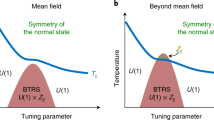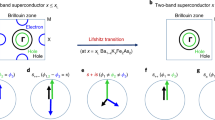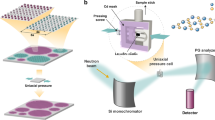Abstract
HEAVY-fermion superconductors (in which the charge carriers have an effective mass ∼100 times the free electron mass) have been the subject of intense study during the past decade1, in part because of the suggestion that some of these materials may exhibit non-conventional pairing mechanisms2. Here we report a demonstration of quantum coherence of the superconducting wavefunction between the conventional superconductor niobium and the recently discovered3 heavy-fermion superconductor UPd2Al3, which is a potential candidate for a non-conventional pairing mechanism4. The experimental method is similar to our earlier work on high-Tc materials5,6: we use a small pointed rod of UPd2Al3 to bridge the gap in an almost closed niobium ring. We observe persistent currents in the composite ring, and trapped flux, which is in discrete quantum states separated by the flux quantum h/2e. Although the observation of phase coherence between UPd2Al3 and niobium may not constrain the nature of the pairing in UPd2Al3, we also observe Josephson-like current-voltage characteristics at the junction, but with very small products of critical current and normal-state resistance. If other possible causes can be eliminated, these small IcRn values may point to a small tunnelling probability between the two superconductors, and hence to unconventional pairing in UPd2Al3
This is a preview of subscription content, access via your institution
Access options
Subscribe to this journal
Receive 51 print issues and online access
$199.00 per year
only $3.90 per issue
Buy this article
- Purchase on Springer Link
- Instant access to full article PDF
Prices may be subject to local taxes which are calculated during checkout
Similar content being viewed by others
References
Steglich, F. et al. Phys. Rev. Lett. 43, 1892–1896 (1979).
Flouquet, J. et al. Physica C185–189, 372–378 (1991).
Geibel, C. et al. Physica C185–189, 2651–2652 (1991).
Geibel, C. et al. Z. Phys. B84, 1–3 (1991).
Gough, C. E. et al. Nature 326, 855 (1987).
Keene, M. N., Jackson, T. J. & Gough, C. E. Nature 340, 210–211 (1989).
Rice, T. M. Jap. J. Appl. Phys. 26 (Suppl. 26-3) 1865–1874 (1987).
Chaudhari, P., Dimos, D. & Mannhart, J. IBM J. Res. Dev. 33, 299–305 (1989).
Wilczek, F. Int. J. mod. Phys. B5, 1273–1312 (1991).
Steglich, F. et al. J. appl. Phys. 57, 3054–3059 (1985).
Han, S., Ng, K. W. & Wolf, E. L. Phys. Rev. Lett. 57, 238–241 (1986).
Kadlin, A. M. & Goldman, A. M. Phys. Rev. Lett. 58, 2275 (1987).
Ambegaokar, V. & Baratoff, A. Phys. Rev. Lett 10, 486–489 (1963).
Author information
Authors and Affiliations
Rights and permissions
About this article
Cite this article
He, Y., Muirhead, C., Bradshaw, A. et al. Coherence of the superconducting wavefunction between the heavy-fermion superconductor UPd2AI3 and niobium. Nature 357, 227–229 (1992). https://doi.org/10.1038/357227a0
Received:
Accepted:
Issue Date:
DOI: https://doi.org/10.1038/357227a0
This article is cited by
-
Andreev reflections and Josephson effects in point contacts between the heavy fermion superconductor URu2Si2 and conventional superconductors
Zeitschrift f?r Physik B Condensed Matter (1995)
Comments
By submitting a comment you agree to abide by our Terms and Community Guidelines. If you find something abusive or that does not comply with our terms or guidelines please flag it as inappropriate.



